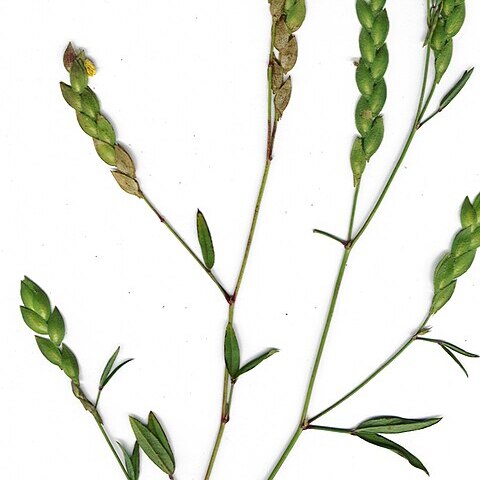Herbs, annual or perennial, usually prostrate or decumbent. Stems slender. Stipules leaflike, spurred basally to point of insertion, basal portion usually divided. Leaves paripinnate, 2[-4]-foliolate; leaflets opposite, subsessile; leaflet blades usually pellucid punctate. Inflorescences axillary or terminal, sparse spikes; bracts usually peltate, stipulelike. Flowers small, usually enclosed in a pair of bracts. Bracteoles absent. Hypanthium short. Calyx small, 2-lipped, adaxial lobes short. Corolla usually yellow; petals ± equal. Stamens monadelphous; anthers dimorphic. Ovary linear, undulate, with 5-8 ovules; style filiform; stigma terminal. Legume a loment, compressed, not stipitate, smooth or surface echinate-setose, indehiscent, divided into few to many subglobose-oblate articles, abaxial suture straight, adaxial suture sinuate, apex usually without a beak. Seeds 1 to several, ovoid or reniform, compressed.
Annual or perennial herbs. Leaves digitately 2-or 4-foliolate; leaflets ± glandular-punctate, exstipellate. Stipules well developed, produced below the point of insertion, often glandular-punctate. Inflorescence spicate, terminal or axillary; bracts in pairs, stipule-like, often glandular-punctate, ciliate, enclosing the flowers when in bud. Calyx hyaline, ciliate, the 2 upper lobes connate. Petals all clawed, forming a normal pea-flower. Stamens with filaments united below into a closed tube; anthers 10, alternately long and short; the upper part of the tube circumscissile, being cast after flowering complete with the stamens and the petals (at least in the tropical African species). Ovary with 5–8 ovules. Legume flattened, segmented, the segments with or rarely without bristles.
Cal irregular, membranous, the 2 upper lobes connate most of their length, the lateral ones much shorter, the lowest one lanceolate, about equaling the upper; standard broadly obovate to suborbicular, much exceeding the other pet; wings short-clawed, the blade half-orbicular, minutely auriculate; keel boat-shaped, obtuse; stamens 10, monadelphous, the tube closed; anthers alternately oblong and globose; fr transversely segmented and eventually separating into 1-seeded indehiscent joints; herbs with palmately compound 2-or 4-foliolate lvs and mostly small fls in interrupted terminal spikes, each fl subtended by a pair of large bracts. 80, warm reg.
Stamens monadelphous, united into a column below, which at maturity is circumscissile and the upper part is shed with the petals, the lower tubular part remaining to protect the young ovary; 5 small versatile anthers alternate with 5 larger sub-basifixed anthers.
Calyx hyaline, ciliate, persistent, 5-lobed, the upper pair joined and the laterals smaller than the other 3.Corolla medium-sized, mostly yellow or orange-yellow, often striated with purple; standard almost round, clawed; wings and keel clawed.
Leaves digitately 2-or 4-foliolate; leaflets mostly glandular-punctate; stipules well developed, produced below the point of insertion, mostly similarly punctate; stipels absent.
Inflorescence spicate, terminal or axillary; bracts paired, stipule-like, mostly similarly punctate, ciliate, enclosing the flowers when in bud.
Fruit sessile, 2–15-jointed; the articles glabrous to pilose with or without stiff bristles, mostly prominently nerved, sometimes glandular.
Ovary subsessile, with (2)5–8 ovules; style curved with minute terminal stigma.
Seeds ovoid, compressed, mostly black or dark brown, without appendages.
Erect or prostrate, perennial or annual herbs.

